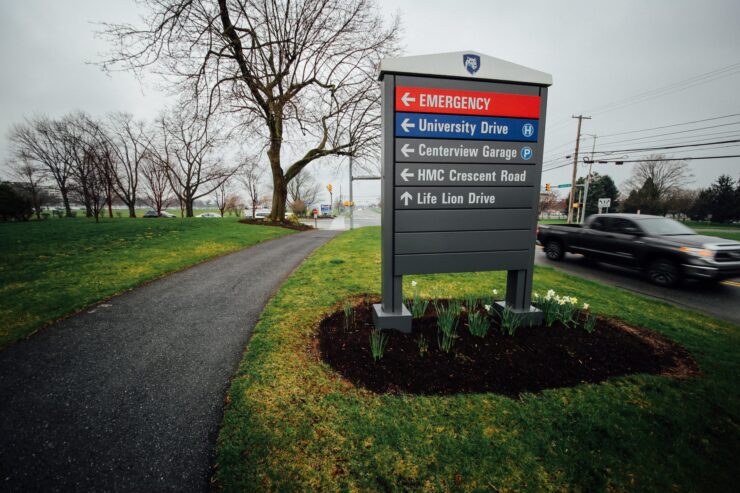In March, just weeks into the COVID-19 pandemic, the incident command center at Brigham and Women’s Hospital in Boston was scrambling to understand this deadly new disease. It appeared to be killing more black and brown patients than whites. For Latino patients, there was an additional warning sign — language.
Patients who didn’t speak much, if any, English had a 35% greater chance of death.
Clinicians who couldn’t communicate clearly with patients in the hospital’s COVID units noticed it was affecting outcomes.
“We had an inkling that language was going to be an issue early on,” says Dr. Karthik Sivashankar, the Brigham’s then medical director for quality, safety and equity. “We were getting safety reports saying language is a problem.”
Sivashankar dove into the records, isolating and layering the unique characteristics of each of the patients who died: their race, age, gender and whether they spoke English.
“That’s where we started to really discover some deeper, previously invisible inequities,” he says.
Inequities that weren’t about race alone.
Hospitals across the country are reporting higher hospitalizations and deaths for Black and Latino patients as compared to whites. Black and brown patients may be more susceptible because they are more likely to have a chronic illness that increases the risk of serious COVID. But when the Brigham team compared Black and brown patients to white patients with similar chronic illnesses, they found no difference in the risk of death from COVID.
Article continues after sponsor message
But a difference did emerge for Latino patients who don’t speak English.
That sobering realization helped them home in on a specific health disparity, think about some possible solutions, and begin a commitment to change.
“That’s the future,” says Sivashankar.
Identifying the mortality risk is just the first step
But first, the Brigham had to unravel this latest example of a life threatening health disparity. It started outside the hospital, in lower-income communities within and just outside Boston, where the coronavirus spread quickly among many native Spanish speakers who live in close quarters with jobs they can’t do from home.
Some avoided coming to the hospital until they were very sick, because they didn’t trust the care in big hospitals or feared detection by immigration authorities. Nevertheless, just weeks into the pandemic, COVID patients who spoke little English began surging into Boston hospitals, including Brigham and Women’s.
” We were frankly not fully prepared for that surge,” says Sivashanker. “We have really amazing interpreter services, but they were starting to get overwhelmed.”
“In the beginning, we didn’t know how to act, we were panicking,” says Ana Maria Rios-Velez, a Spanish-language interpreter at the Brigham.
Rios-Velez remembers searching for words to translate this new disease and experience for patients. When called to a COVID patient’s room, interpreters were confused about whether they could go in, and how close they should get to a patient. Some interpreters say they felt disposable in the early days of the pandemic, when they weren’t given adequate personal protective equipment.
When she had PPE, Rios-Velez says she still struggled to gain a patient’s trust from behind a mask, face shield and gown. For safety, many interpreters were urged to work from home. But speaking to patients over the phone created new problems.
“It was extremely difficult, extremely difficult,” she says. “The patients were having breathing issues. They were coughing. Their voices were muffled.”
And Rios-Velez couldn’t look her patients in the eye to put them at ease and try to build a connection.
“It’s not only the voice, sometimes I need to see the lips, if smiling,” she says. “I want them to see the compassion in me.”
Adding interpreters and telemedicine tech
The Brigham responded by adding more interpreters and buying more iPads so that remote workers could see patients. The hospital purchased amplifiers to raise the volume of the patient’s voice above the beeps and machines humming in an ICU. The Mass General Brigham network is piloting the use of interpreters available via video in primary care offices. A study found lower use of telemedicine visits by Spanish-speaking patients as compared to white patients during the pandemic.
The Brigham’s goal is that every patient who needs an interpreter will get one. Sivashankar says that happens now for most patients who make the request. The bigger challenge, he says, is including an interpreter in the care of patients who may need the help but don’t ask for it.
In the midst of the first surge, interpreters also became translators for the hospital’s website, information kiosks, COVID safety signs and brochures.
“It was really tough. I got sick and had to take a week off,” saysYilu Ma, the Brigham’s director of interpreter services.
Mass General Brigham is now expanding a centralized translation service for the entire hospital network.
Seeing the inequities within the hospital workforce
Brigham and Women’s analytics team uncovered other disparities. Lower-paid employees were getting COVID more often than nurses and doctors. Sivashankar says there were dozens of small group meetings with medical assistants, transport workers, security staff and those in environmental services where he shared the higher positive test rates and encouraged everyone to get tested.
“We let them know they wouldn’t lose their jobs,” if they had to miss work, Sivashankar says. And he, along with managers, told these employees “that we realize you’re risking your life just like any other doctor of nurse is, every single day you come to work.”
Some employees complained of favoritism in the distribution of PPE, which the hospital investigated. To make sure all employees were receiving timely updates as pandemic guidance changed, the Brigham started translating all coronavirus messages into Spanish and other languages, and sending them via text, which people who are on the move all day are more likely to read. The Mass General Brigham system offered hardship grants of up to $1,000 for employees with added financial pressures, such as additional child care costs.
Angelina German, a hospital housekeeper with limited English, says she appreciates getting updates via text in Spanish, as well as in-person COVID briefings from her bosses.
“Now they’re more aware of us all,” German says through an interpreter, “making sure people are taking care of themselves. ”
Moving beyond the hospital walls to address disparities
The hospital also set up testing sites in some Boston neighborhoods with high coronavirus infection rates, including neighborhoods where many employees live and were getting infected. At least one of those sites now offers COVID vaccinations.
“No one has to be scheduled, you don’t need insurance, you just walk up and we can test you,” explained Dr. Christin Price during a visit to one of the testing sites last fall. It was located in the parking lot of Brookside Community Health Center, in Boston’s Jamaica Plain neighborhood.
Nancy Santiago left the testing site carrying a free 10-pound bag of fruits and vegetables, which she’ll share with her mother. Santiago said she’s grateful for the help.
“I had to leave my job because of [lack of] daycare, and it’s been pretty tough,” she said, “but you know, we gotta keep staying strong and hopefully this is over sooner rather than later.”
The Brigham recently opened a similar indoor operation at the Strand Theater in Dorchester. Everyone who comes for a coronavirus test is asked if they have enough to eat, if they can afford their medications, whether they need housing assistance and if they’re registered to vote.
The bags of free food, and the referrals to social support, are evidence of a debate playing out about the role hospitals will play, outside their walls, to curb health disparities rooted in racism.
“Poverty and social determinants of health needs are not going away any time soon, and so if there’s a way to continue to serve the communities, I think that would be tremendous,” says Price, who helped organize the Brigham’s community testing program.
Mass General Brigham leaders say they’ll take what they’ve learned dissecting disparities during the COVID-19 pandemic, and expand the remedies across the hospital network.
“Many of the issues that were identified during the COVID equity response are unfortunately pretty universal issues that we need to address, if we’re going to be an anti-racist organization and one that promotes equity strongly as one of our core strategies,” says Tom Sequist, chief of patient experience and equity for Mass General Brigham.
The Brigham’s work on health disparities comes, in part, out of a collaboration with the Institute for Healthcare Improvement (IHI), and included a focus on gathering, analyzing and tracking data.
“There’s a lot of defensive routines into which we slip as clinicians, that the data can help cut through and reveal that there are some biases in your own practice,” explains IHI President and CEO Dr. Kedar Mate.
“If we don’t name and start to talk about racism and how we intend to dismantle it or undo it,” Mate adds, “we’ll continue to place Band-Aids on the problem and not actually tackle the underlying causes.”
But has the Brigham’s work lowered the risk of death from COVID for Spanish-speaking patients? The hospital hasn’t updated the analysis yet, and even when it does, determining whether (or how) the interventions worked will be hard to prove, Sivashankar says.
“It’s never going to be as simple as ‘We just didn’t give them enough iPads or translators and that was the only problem,’ and now that we’ve given that, we’ve shown that the mortality difference has gone away,” said Sivashankar.
But Sivashankar says more interpreters, iPads, and better messaging to non-English speaking employees, plus all the other steps the Brigham has taken during COVID have improved both the patient and employee experience. That, he says, counts as a success, while work on the next layer of discrimination continues.
https://harbourlightsmarina.on.ca/advert/live-2021-ncaa-field-hockey-selection-show-live-stream-how-to-watch-online-free-channel/
https://harbourlightsmarina.on.ca/advert/watch-2021-ncaa-field-hockey-selection-show-livestream-free-hd-tv-channel/
https://harbourlightsmarina.on.ca/advert/2021-ncaa-field-hockey-selection-show-live-stream-free-tv/
https://harbourlightsmarina.on.ca/advert/watchtv-ncaa-field-hockey-selection-show-2021-live-stream-online-free-tv-channel/
https://harbourlightsmarina.on.ca/advert/watch-free-ncaa-field-hockey-selection-show-2021-live-stream-hockey-competiton-online/
https://harbourlightsmarina.on.ca/advert/ncaa-field-hockey-selection-show-2021-live-stream-free-reddit-tv/
https://harbourlightsmarina.on.ca/advert/2021-division-i-field-hockey-selection-show-livestream-online-free-tv-channel/
https://harbourlightsmarina.on.ca/advert/watch-2021-division-i-field-hockey-selection-show-live-stream-online-free/
https://harbourlightsmarina.on.ca/advert/2021-division-i-field-hockey-selection-show-live-stream-free/
https://harbourlightsmarina.on.ca/advert/watch-tv-division-i-field-hockey-selection-show-2021-live-streaming-online-free/
https://harbourlightsmarina.on.ca/advert/live-tv-division-i-field-hockey-selection-show-2021-livestream-free-online-hd-tv-channel-2/
https://harbourlightsmarina.on.ca/advert/live-division-i-field-hockey-selection-show-2021-live-stream-free/




























